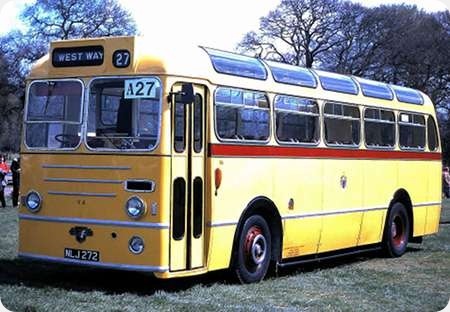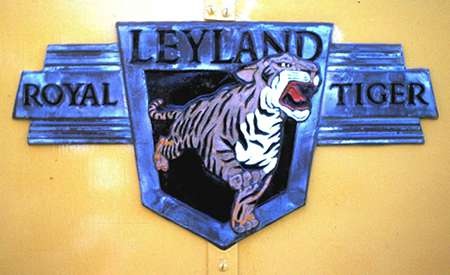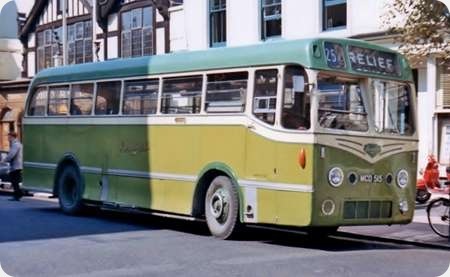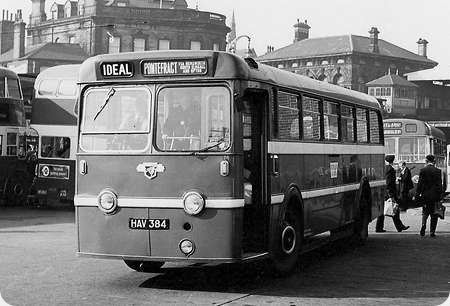
Copyright R F Mack
Ideal Service (R Taylor & Son)
1952
Leyland Royal Tiger PSU1/13
Leyland B44F
The attached Photograph dating back to the 1950 show HAV 384 in Barnsley Bus station preparing to
depart for Pontefract on the Ideal service route run jointly with H Wray & Son. This vehicle was new to
Simpsons of Rosehearty before being acquired by Taylors. The driver is Dennis Taylor, his older brother
Len also drove. This was in fact one of the buses used on my school run on a morning and tea time to the
High School and Kings School in Pontefract. This involved 5 buses on the morning and afternoon run. The
morning being the worst as I lived in a village which was the last port of call into Pontefract and 1 of
the 5 was the service bus you would put your hand out and eventually one would stop. Although the
service ran in all weathers its time keeping was not what you would call excellent. It left the top of
my village at 10 to the hour and arrived any time between 20 to and 10 past. You could always guarantee
a place on the last bus from Pontefract on a Saturday night. They never left any one, a 35 seater was
stopped by the police one night and 72 occupants alighted!!!
Photograph and Copy contributed by Brian Lunn
06/08/15 - 05:50
Mention of packed last buses brings to mind the apocryphal story of the last
Pennine bus from Skipton which had a passenger sat alongside the engine on the near side
mudguard!
Chris Hough
06/08/15 - 05:52
How very interesting! Thank you for posting this. It raises a little query
which, perhaps, ought to be in the "Q&A" section.
I have a bought slide of JWF 885,
an Albion CX13, which was listed in my source’s catalogue as belonging to Ideal, Wray & Son, of
Harrogate. We’re not talking of the same firm here, I suppose. Are we?
Pete Davies
06/08/15 - 07:54
Pete the Wrays of Harrogate I think were based at Starbeck, they were mainly a
coach operation if I remember right. They sold out to Eddie Brown. H. Wray of the Ideal service were
based in Lord Street Hoyle Mill Barnsley, where I think it was the 4pm out of Barnsley used to stop
to fill up complete with passengers before continuing on its route.
Brian Lunn
06/08/15 - 11:22
Thank you, Brian. I thought my assorted sources might be wrong - again.
Pete Davies
06/08/15 - 11:22
JWF 885 belonged to France (Ideal Motor Services), Market Weighton, East
Yorkshire.
David Hick
06/08/15 - 11:23
JWF 885 was new to Baldry of Sancton in 7/51 it passed to France’s Motors T/A
Ideal of Market Weighton in 1/54, both in the East Riding of Yorkshire.
JWF was a Albion FT39N
with Barnaby or Scottish Aviation body!!
Ideal is still operating today, but is now part of
York Pullman, but is kept as a separate business still in its original green livery
Mike Davies
06/08/15 - 11:24
I’m a little puzzled here: I thought that Leyland gave up building single deck
bodies, in favour of just double deck ones, as a peacetime decision, at least until it had to with
the Leyland National/Lynx. Am I wrong, or was this a one-off demonstrator?
Chris Hebbron
06/08/15 - 15:40
Hi CH
There are 5 pictures of post war Leyland bodied SDs on SCT ’61
photo index Body Builder-Leyland picture number 249 onwards plus more further down.
John Lomas
07/08/15 - 07:17
I read an item on Simpsons and they received three of these Tigers HAV384/5/6
There is a photo on flicker of HAV386 I also understand that the 3 were mentioned in the Leyland Bus
book, however I am unable to check this as I am in the process of sorting my book storage and I can
not put my had on the book in question.
Brian Lunn
07/08/15 - 07:17
Interesting to read Mike Davies’ comment about JWF 885 having a Barnaby or
Scottish Aviation body. The PSV Circle records it as Barnaby but I have a recollection of visiting
France at Market Weighton some 40 years ago and seeing it with a Scottish Aviation body sticker. For
all that time I’ve thought I must have been mistaken but here is some other evidence that points
that way.
Answers on a postcard.
John Carr
07/08/15 - 07:18
Brian, it was W. Pyne & Sons who were based in Starbeck (on Camwal Road) and
their white and purple coaches were a familiar sight around the area for many years. Wray’s operated
from their garage at Dacre Banks, which is between Harrogate and Pateley Bridge. Their coaches
usually had ‘Wray’s of Summerbridge" on the rear however - Summerbridge being a larger
village, literally just over the River Nidd from Dacre Banks. (Presumably Wray’s felt people would
know where Summerbridge was, but might not with Dacre Banks!). Wray’s livery was mid-grey,
greeny-grey and red, and the firm’s coaches could often be seen in the summer months with windscreen
stickers proclaiming "On Hire To West Yorkshire". Indeed, some of their distinctive
coaches could be often be seen parked on the forecourt of WY’s Grove Park depot in Harrogate. At one
time Wray’s fleet included a Yeates-bodied AEC Reliance and Yeates-bodied Bedford SB, whose
flamboyant styling provided an interesting contrast as they rubbed shoulders with the classic lines
of WY’s ECW-bodied LS, MW and RE coaches.
Brendan Smith
07/08/15 - 07:19
There is more info for W Pyne & Son Starbeck at this link
Peter
07/08/15 - 09:21
Thanks Brendan for the correction, I remember now. I should have twigged as I
travelled past their garage at Dacre Banks often. I do remember seeing the "On hire to West
Yorkshire" as you say in the busy period.
Brian Lunn
07/08/15 - 17:07
Chris, your comments re Leyland single deck bodies prompted me to plough
through my old issues of Classic Bus as something rang a bell (issue 5, June-July 1993). You are
right that Leyland did focus on only double deck bodies immediately post war, due to the huge demand
for them at the time. This lead to the successful Farington body in 1950 which was built until 1954.
The single deck bodies came about following the integral Olympic project in 1949, in conjunction
with MCW. After that they produced two standardised single deck bodies for the Royal Tiger, the
familiar all metal, centre entrance coach body from 1950, and the rather angular bus version from
1951. Nothing followed for the Tiger Cub so, as you have stated, next in line was the National,
nearly two decades later.
Mike Morton
08/08/15 - 09:24
The photo of HAV 384 could only have been taken in the mid-1960s, since
Simpsons themselves were running it well into the decade.
There were only two vehicles in the
batch, HAV 384 and HAV 385 - the latter operated for Garner, Bridge of Weir after service with
Simpsons.
‘HAV 386’ was an invention of the Ribble Vehicle Preservation Group, the
vehicle which has appeared in photographs showing that registration was really ERN 709, originally
Ribble 386, later with UTA/Ulsterbus.
Talking of Wrays of Dacre Banks, didn’t they too finish
up somewhere in the Knaresborough area? Whether or not it was Starbeck I don’t know, I don’t know
the area all that well.
David Call
08/08/15 - 10:18
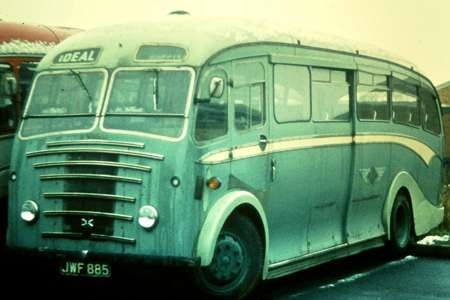
Well, this does get confusing. I’m glad I asked. I’m attaching a view of my
bought slide, which doesn’t look to have a very green livery to me, unless it’s a combination of
scanning a bought slide which may or may not have rendered the original properly, and my less than
pristine eyesight. As noted in my original comment, it was listed as a CX13.
Chris, Leyland
built large numbers of bodies in both bus and coach form on the Royal Tiger, many of them for
Ribble. They finally gave up body building in about 1953. My understanding has always been that they
were too busy on chassis to afford to have anyone on building bodies. Look under Pennine in the
operators section in the column on the left of the page for a view of the demonstrator Royal Tiger
coach. I believe Baxters of Airdrie had a former demonstrator in bus form.
Pete Davies
08/08/15 - 15:32
Pete, I think the Baxter’s vehicle you have in mind would be NTJ 985, but it
wasn’t an ex-demonstrator, it had been new to Corless of Charnock Richard. After the takeover of
Baxter’s by Eastern Scottish it ran in the latter’s livery for a while. //www.sct61.org.uk/xb107
David Call
09/08/15 - 06:40
Thank you, David. Now, any other words of advice from anyone about JWF?
Pete Davies
09/08/15 - 09:57
Thanks, Mike M & Pete D for reminding me of Leyland’s coach version of the
Royal Tigers’ body, which I DO recall now, working for Southdown. I never remember seeing the bus
version, perhaps because they tended to be and stay ‘oop North’!
Chris Hebbron
10/08/15 - 05:43
There’s a photo of JWF at https://www.flickr.com/photos/
which says it’s an FT39N with Scottish Aviation 31-seat body. In view of the
size I would definitely rule out CX13, and although I have never before seen a Scottish Aviation
body with a curved window line (the windows don’t look very happy, so perhaps it’s the only one they
built!), the trimmings do look exactly like theirs.
Peter Williamson
10/08/15 - 11:23
Thank you, Peter W!
Pete Davies
18/08/15 - 05:40
The two buses HAV 384 and 385 left the Simpson fleet in March 1961 and October
1960.
HAV 384 going directly to Taylor of Cudworth part of the Ideal consortium. They sold the
vehicle to Mellers of Goxhill in October 1967. It operated for them until October 1968.
HAV
385 went directly to Garner of Bridge of Weir in October 1960 and then to Tiger Coaches of Salsburgh
in March 1967.
From my own notes and checked with the PSV Circle publication SAD1, pre war
operators in Aberdeenshire and Kincardineshire.
Stephen Bloomfield
18/08/15 - 10:36
It seems I was a few years out in my estimation of when Simpson’s disposed of
HAV384 - anyway, at least it wasn’t in the 1950s.
Does anyone know why Simpson’s sold HAV
384/5 at such an early age? A year or two later they were buying secondhand Royal Tigers of similar
vintage. //public.fotki.com/boballoa/1/
David Call
